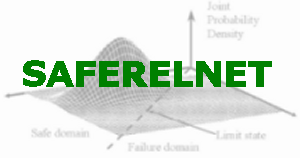 |
 |
 |
 |
| Thematic Network on Safety and Reliability of Industrial Products, Systems and Structures | |||
| segunda-feira, 15 de dezembro de 2025 | |||
       |
| WP 3 - Human and Organisational Factors in Risk Assessments | ||||||
|
WP Leader: DAP Objectives To deal with the approaches to model the effect of human actions on the safety and reliability of systems, in particular how human and organisational actions can lead to accidents. Consideration of the approaches to include their influence in risk assessments, in particular in high consequence situations which are very dependent of the human actions, and the need to integrate human actions and uncertainties with component risk and reliability models. A principal consideration is competence, both for the risks presented to the safe and cost-effective operation of facilities and for the execution of the subject risk and reliability evaluations being considered by the Network. The WP therefore provides a direct influence on WP9 (Training and Education) as well as WP10. Task 3.1 – Techniques for Human Reliability Evaluation Task leader: BOMEL This task will analyse how the human and organisational factors are addressed in the various industries, to understand whether they may affect safety. These factors will be set alongside the traditional considerations of engineers designing and managing infrastructure. This task will review qualitative and quantitative techniques for assessing human and organisational influences on the safety and reliability of systems. Techniques such as influence networks to measure performance and the relative significance of hardware, software and these 'liveware' failures and the effectiveness of risk control options will be described. Considerations will range from direct influences such as fatigue, through to training, management procedures, corporate policy and regulatory issues. All humans involved in the life cycle of a product or system, i.e. starting from the designer till the final users will be considered to understand how the ultimate safety of the system may be affected. Task 3.2 – Data for Human Reliability Evaluation Task leader: RISOE The task will address data relative to human reliability evaluations. A review will be made of major extent data sources of human reliability data and human performance and human error types for which quantified and generalisable data are not readily available will be characterised. Reliability issues pertaining to the classification, identification and quantification of human errors will be described. Finally, an analysis will be presented of some accidents and incidents that illustrate types of errors that are, respectively are not well captured by HRA techniques. The report will list recommendations for data gathering mechanisms in different domains. Task 3.3 – Integration of Human and Organisational Factors in Risk and Reliability Assessments Task leader: DAP This task will address how the most safety related human and organisational factors could be integrated in risk and reliability models. Both QRA for systems as well as SRA for structural systems will be considered. Ultimately, methods and groups of methods will be selected and recommended as those most suitable to cover the end-users needs. Gaps and deficiencies of the methods will be identified, and needs for further research will be recommended. |
||||||
| (Back) | ||||||
| Home | Overview | Structure | Workplan | Members | Meetings | Login |
| ©
2002 SAFERELNET Optimized for Internet Explorer 5+ |